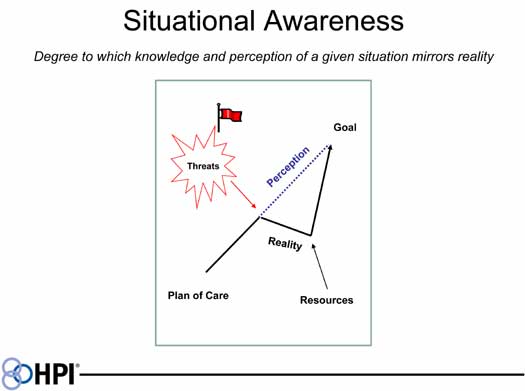High Reliability Healthcare: Applying CRM to High-Performing Teams, Part 7
In this series, Steve Kreiser describes a model for applying aviation’s crew resource management to healthcare. This model incorporates different elements inherent in most CRM programs but has an additional benefit of including simple error prevention tools and techniques that help reduce human error. These seven tools, essentially a “people bundle” to make humans more reliable, can help individuals experience fewer errors while encouraging teams to catch and trap those errors that do still occur in complex systems. The series will continue on conclude on Thurs. Jan.19.
Element #6 – Situational Awareness
Situational awareness is the degree to which knowledge and perception of a given situation mirrors reality. Figure 4 shows how threats such as distractions, miscommunication, poor attention to detail, workarounds or other problems can cause a situation to deteriorate and get off track. A team with good situational awareness recognizes these “red flags” and the reality of the situation, then applies the necessary resources to adjust back toward the goal of the plan of care. A team with poor situational awareness fails to recognize a deteriorating condition and continues down a path that can lead to a bad outcome. All of the previously discussed elements of CRM should be used to build and maintain a high degree of situational awareness, with the ultimate goal being to make better decisions in the interest of patient care.

Figure 4.
At Cincinnati Children’s Hospital Medical Center, this concept of building and sustaining high situational awareness was put into practice with the implementation of a Pediatric Early Warning System (PEWS) to identify and quickly respond to patients with deteriorating clinical conditions. The “red flags” were described using three specific indicators of patient health – behavior, cardiovascular status, and respiratory status. The team maintained high situational awareness to avoid getting off the plan of care by scoring patients in each of these areas using an internally developed algorithm and prominently displayed the score on a unit white board.
Patients with low scores based on the scoring algorithm were determined to need no intervention. However, patients with high scores were quickly identified as needing further assessment or intervention, up to and including the activation of the hospital’s medical response team. The increased situational awareness gained using this approach reduced in-unit codes, mortality and length of stay while also contributing to improved teamwork and communication on the part of staff.1
High Reliability Tip #6 – Use a three-step process to build good situational awareness: Know the Threats by discussing them in briefs, Look for the Threats using the “big lens, little lens”, while paying attention to detail and employing healthy questioning attitudes, and Communicate the Threats to fellow team members using clear communications.
Watch for the conclusion of this series, Element #7 – Decision Making, on Thurs., Jan. 19.
Steve Kreiser is a consultant with Healthcare Performance Improvement (HPI). previously, Kreiser was an FA-18 pilot with more than 21 years of experience in the U.S. Navy, and a first officer for a major airline, where he worked extensively in the area of crew resource management. Mr. Kreiser can be contacted at steve@hpiresults.com.
Reference
